Human civilization - Study guides, Class notes & Summaries
Looking for the best study guides, study notes and summaries about Human civilization? On this page you'll find 1109 study documents about Human civilization.
Page 3 out of 1.109 results
Sort by
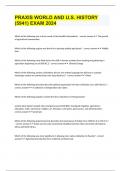
-
PRAXIS WORLD AND U.S. HISTORY (5941) EXAM 2024
- Exam (elaborations) • 53 pages • 2024
-
- $16.49
- + learn more
PRAXIS WORLD AND U.S. HISTORY (5941) EXAM 2024 Which of the following was a direct result of the Neolithic Revolution? - correct answer The growth of agricultural communities Which of the following regions was the first to develop settled agriculture? - correct answer Middle East Which of the following most likely led to the shift in human societies from hunting and gathering to agriculture beginning circa 8,000 B.C.E - correct answer Climate Change Which of the following ancient ...

-
CPSC 113 Final Exam 2023 with correct answers
- Exam (elaborations) • 23 pages • 2023
-
- $12.99
- 1x sold
- + learn more
This person, a NASA scientist, stated that they found alien remains on Earth and they could prove it: a) Richard Doll b) Richard Hoover c) James Lovelock d) Carl Sagan e) Tyron Hayes b) Richard Hoover Cyanobacteria fossils were found in meteorites, which NASA says proves that there is life on other planets. True or False False Antarctica's blood red waterfall can be blamed on: a) Sulfer b) Iron c) Methane d) Carbon Dioxide e) Chloride b) Iron To give a nonhuma...
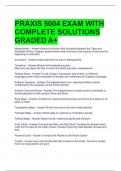
-
PRAXIS 5004 EXAM WITH COMPLETE SOLUTIONS GRADED A+
- Exam (elaborations) • 21 pages • 2024
- Available in package deal
-
- $11.99
- + learn more
PRAXIS 5004 EXAM WITH COMPLETE SOLUTIONS GRADED A+ Mesopotamia - Answer-Ancient civilization that flourished between the Tigris and Euphrates Rivers. Irrigation systems were done resulting in the surplus of food and the beginning of civilization Sumerians - Answer-helped develop the area in Mesopotamia Cuneiform - Answer-Worlds first handwriting system May have also been the first to invent the wheel and plow- mesopotamia Rosetta Stone - Answer-Found in Egypt. Information was written...
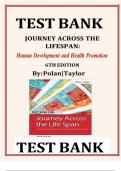
-
TEST BANK: Journey Across the Life Span: Human Development and Health Promotion( Elaine U. Polan and Daphne R. Taylor) 7th Edition latest update 2024 | complete guide A+.
- Exam (elaborations) • 336 pages • 2024
-
- $17.99
- + learn more
Test Bank: Journey Across The Life Span: Human Development and Health Promotion, 6th Edition Polan Table of Contents: Chapter 1. Healthy Lifestyles Chapter 2. Communication Chapter 3. Culture Chapter 4. The Family Chapter 5. Theories of Growth and Development Chapter 6. Prenatal Period to 1 Year Chapter 7. Toddlerhood Chapter 8. Preschool Chapter 9. School Age Chapter 10. Puberty and Adolescence Chapter 11. Early Adulthood Chapter 12. Middle Adulthood Chapter 13. Late Adultho...

-
FSE 112 Final Exam Questions and Answers Already Passed
- Exam (elaborations) • 23 pages • 2024
- Available in package deal
-
- $9.99
- + learn more
FSE 112 Final Exam Questions and Answers Already Passed In the Middle Ages, who were typically buried in coffins? People of high social status or significant importance. Who was tasked with embalming Martin Van Butchell's wife? John Hunter The Greek stelae are also referred to as ____ tombs. Shaft The term "anthropomorphic" describes early Egyptian coffins shaped like a _____. Human figure Which ancient culture envisioned a paradise called the "Elysian Fields" for thei...
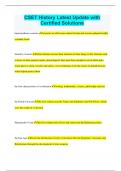
-
CSET History Latest Update with Certified Solutions
- Exam (elaborations) • 50 pages • 2023
- Available in package deal
-
- $12.99
- + learn more
CSET History Latest Update with Certified Solutions hunter/gatherer societies societies in which men started to hunt and women gathered readily available foods hiearchy of needs before human can turn their attention to finer things in life, humans need to focus on their primary needs- physiological- they must have enough to eat or drink and a warm place to sleep- security and safety- river settlements were the easiest to defend because water helped protect them the four characteristics of civi...
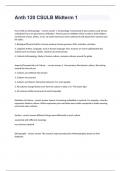
-
Anth 120 CSULB Midterm 1 questions with correct answers 2024
- Exam (elaborations) • 13 pages • 2024
- Available in package deal
-
- $17.99
- + learn more
Anth 120 CSULB Midterm 1Four Fields of anthropology: - correct answer 1. Archaeology: (reminisced of past cultures, past human civilization) Focus on past human civilization. They focused on Midden which is trash as shell middens reminiscent of toys, fabrics, or etc. by native Americans were collected to tell about their nutrients and life styles. 2. Biological/Physical Anthro: Human anatomy, human genome, DNA, evolution, primates 3. Linguistic Anthro: Language, such as human language. Also, h...

-
MTTC History: Practice test Questions & 100% Correct Answers- Latest Test | Graded A+ | Passed
- Exam (elaborations) • 52 pages • 2024
- Available in package deal
-
- $13.49
- + learn more
Where was the first great human civilization located? -:- The first great human civilization was the Sumerian civilization which was located in Mesopotamia. Mesopotamia encompasses the area between the Tigris and Euphrates Rivers in modern-day Iraq and is also referred to as "the Cradle of Civilization," and includes part of the Fertile Crescent. The Sumerian civilization is credited with being the first to practice serious, year round agriculture. There is question over whether Su...
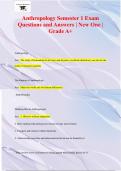
-
Anthropology Semester 1 Exam Questions and Answers | New One | Grade A+
- Exam (elaborations) • 75 pages • 2024
- Available in package deal
-
- $17.89
- + learn more
Anthropology Ans: The study of humankind in all times and all places (textbook definition), can also be the study of migratory patterns The Purpose of Anthropology Ans: Make the world safe for human differences -Ruth Benedict Thinking like an Anthropologist Ans: 1. Observe without judgement 2. Infer (making educated guesses) based on logic and evidence 3. Compare and contrast without hierarchy 4. Acknowledge your bias and ethnocentrism but do not be limited by it "You can best ser...
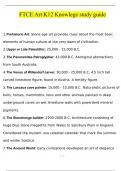
-
FTCE Art K12 Knowledge Study Guide Questions with 100% Correct Answers | Verified | Latest Update
- Exam (elaborations) • 32 pages • 2024
- Available in package deal
-
- $12.99
- + learn more
1. Prehistoric Art: Stone age art provides clues about the most basic elements of human culture at the very dawn of civilization. 2. Upper or Late Paleolithic: 25,000 - 15,000 B.C. 3. The Panaramitee Petroglypher: 43,000 B.C. Aboriginal abstractions from South Australia. 4. The Venus of Willendorf carver: 30,000 - 25,000 B.C. 4.5 inch tall carved limestone figure, found in Austria. A fertility figure. 5. The Lascaux cave painter: 15,000 - 10,000 B.C. Naturalistic pictures of bulls, horses, m...

$6.50 for your textbook summary multiplied by 100 fellow students... Do the math: that's a lot of money! Don't be a thief of your own wallet and start uploading yours now. Discover all about earning on Stuvia


